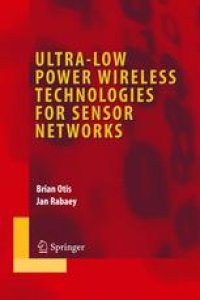
Ebook: Ultra-Low Power Wireless Technologies for Sensor Networks
Author: Brian Otis Jan Rabaey (auth.)
- Tags: Circuits and Systems, Electronics and Microelectronics Instrumentation, Signal Image and Speech Processing, Communications Engineering Networks, Electronic and Computer Engineering
- Year: 2007
- Publisher: Springer US
- Edition: 1
- Language: English
- pdf
Ultra-Low Power Wireless Technologies for Sensor Networks is written for academic and professional researchers designing communication systems for pervasive and low power applications. The main emphasis of the book is on design techniques for low power, highly integrated transceivers. Instead of presenting a single design perspective, this book presents the design philosophies from three diverse research groups, providing three completely different strategies for achieving similar goals. The following transceiver styles are represented:
- MEMS-assisted super-regenerative transceiver architecture
- Ultra-wideband transceiver architecture
- Low-IF CMOS transceiver architecture
The design of RF transceiver circuits and architectures is historically (and notoriously) heuristic. By presenting diverse perspectives on transceiver design, Ultra-Low Power Wireless Technologies for Sensor Networks prepares the reader for the countless design decisions they will be making in their own designs.
Ultra-Low Power Wireless Technologies for Sensor Networks also includes invited chapters: "Ultra-Low Power Radio in a Package Using Ultra-Wideband Technology" by Julien Ryckaert and Steven Sanders from Interuniversity Microelectronics Centre and "Low Energy Wireless Communication" by Ben Cook and Kris Pister from the University of California, Berkeley.
Ultra-Low Power Wireless Technologies for Sensor Networks is written for academic and professional researchers designing communication systems for pervasive and low power applications. The main emphasis of the book is on design techniques for low power, highly integrated transceivers. Instead of presenting a single design perspective, this book presents the design philosophies from three diverse research groups, providing three completely different strategies for achieving similar goals. The following transceiver styles are represented:
- MEMS-assisted super-regenerative transceiver architecture
- Ultra-wideband transceiver architecture
- Low-IF CMOS transceiver architecture
The design of RF transceiver circuits and architectures is historically (and notoriously) heuristic. By presenting diverse perspectives on transceiver design, Ultra-Low Power Wireless Technologies for Sensor Networks prepares the reader for the countless design decisions they will be making in their own designs.
Ultra-Low Power Wireless Technologies for Sensor Networks also includes invited chapters: "Ultra-Low Power Radio in a Package Using Ultra-Wideband Technology" by Julien Ryckaert and Steven Sanders from Interuniversity Microelectronics Centre and "Low Energy Wireless Communication" by Ben Cook and Kris Pister from the University of California, Berkeley.
Ultra-Low Power Wireless Technologies for Sensor Networks is written for academic and professional researchers designing communication systems for pervasive and low power applications. The main emphasis of the book is on design techniques for low power, highly integrated transceivers. Instead of presenting a single design perspective, this book presents the design philosophies from three diverse research groups, providing three completely different strategies for achieving similar goals. The following transceiver styles are represented:
- MEMS-assisted super-regenerative transceiver architecture
- Ultra-wideband transceiver architecture
- Low-IF CMOS transceiver architecture
The design of RF transceiver circuits and architectures is historically (and notoriously) heuristic. By presenting diverse perspectives on transceiver design, Ultra-Low Power Wireless Technologies for Sensor Networks prepares the reader for the countless design decisions they will be making in their own designs.
Ultra-Low Power Wireless Technologies for Sensor Networks also includes invited chapters: "Ultra-Low Power Radio in a Package Using Ultra-Wideband Technology" by Julien Ryckaert and Steven Sanders from Interuniversity Microelectronics Centre and "Low Energy Wireless Communication" by Ben Cook and Kris Pister from the University of California, Berkeley.
Content:
Front Matter....Pages i-xiii
Wireless Sensor Networks....Pages 1-12
Low Power CMOS Design for Radio Frequencies....Pages 13-39
Two Channel Baw-Based Transceiver....Pages 41-60
Super-Regenerative Receiver Design....Pages 61-79
Fully Integrated Super-Regenerative Transceiver....Pages 81-101
Integration Techniques....Pages 103-116
Ultra-Low Power Radio in a Package Using Ultra-Wide Band Technology....Pages 117-142
Low Energy Wireless Communication....Pages 143-169
Conclusions....Pages 171-173
Back Matter....Pages 175-184
Ultra-Low Power Wireless Technologies for Sensor Networks is written for academic and professional researchers designing communication systems for pervasive and low power applications. The main emphasis of the book is on design techniques for low power, highly integrated transceivers. Instead of presenting a single design perspective, this book presents the design philosophies from three diverse research groups, providing three completely different strategies for achieving similar goals. The following transceiver styles are represented:
- MEMS-assisted super-regenerative transceiver architecture
- Ultra-wideband transceiver architecture
- Low-IF CMOS transceiver architecture
The design of RF transceiver circuits and architectures is historically (and notoriously) heuristic. By presenting diverse perspectives on transceiver design, Ultra-Low Power Wireless Technologies for Sensor Networks prepares the reader for the countless design decisions they will be making in their own designs.
Ultra-Low Power Wireless Technologies for Sensor Networks also includes invited chapters: "Ultra-Low Power Radio in a Package Using Ultra-Wideband Technology" by Julien Ryckaert and Steven Sanders from Interuniversity Microelectronics Centre and "Low Energy Wireless Communication" by Ben Cook and Kris Pister from the University of California, Berkeley.
Content:
Front Matter....Pages i-xiii
Wireless Sensor Networks....Pages 1-12
Low Power CMOS Design for Radio Frequencies....Pages 13-39
Two Channel Baw-Based Transceiver....Pages 41-60
Super-Regenerative Receiver Design....Pages 61-79
Fully Integrated Super-Regenerative Transceiver....Pages 81-101
Integration Techniques....Pages 103-116
Ultra-Low Power Radio in a Package Using Ultra-Wide Band Technology....Pages 117-142
Low Energy Wireless Communication....Pages 143-169
Conclusions....Pages 171-173
Back Matter....Pages 175-184
....